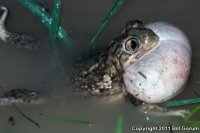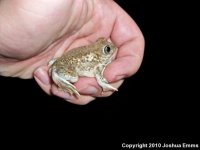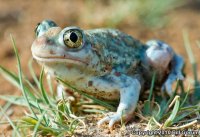| Range: |
 |
| Other Names: |
|
| Description: |
The Plains spadefoot is typically a brown, reddish-brown, or olive spadefoot with a maximum length of about 2.5 inches. It has large eyes with vertical pupils, typical of spadefoots, and a bony boss between the eyes. There are often 4 light stripes down the back, the middle of which may form an hourglass. It is named for the wedge-shaped black, horny tubercle or spade on the bottom of each hind foot. Tadpoles occur either as cannibalistic morphs that are large, flat-headed, and with enlarged jaw muscles; or as omnivores, which have a more rounded body shape and smaller jaw muscles. Both forms have relatively broad, flat heads with eyes close together and positioned high on the head. Tadpoles are gray or brown and grow to 2.75 inches. |
| Similar Species: |
This species is often confused with the Mexican spadefoot, with which it is often sympatric. The calls of the two species are quite distinct, and Mexican spadefoots typically smell like peanuts when handled. |
| Habitat: |
This species occurs in open country characterized by grasslands, Great Basin Desert, or open, pinyon-juniper woodlands. It needs loose, well-drained soils for burrowing and aestivating, and ephemeral rain pools, playas, cattle ponds, or still water along arroyo bottoms with few or no predators for breeding. |
| Behavior: |
Plains spadefoots are primarily nocturnal, but adults may be active during the day while breeding. Metamorphs are often diurnal as well. |
| Hibernation: |
Underground |
| Reproduction: |
Like other spadefoots, this species remains buried in the ground for months at a time and then emerges during heavy rainfall to breed and feed. It breeds in rain pools that form during the summer monsoons throughout its range in Arizona, but breeding in the spring may occur in northeastern Arizona, as well. Breeding occurs "explosively" the first night during or after a heavy rain. Males call from the shallows at the edge of the pond; the call is a rapid trill lasting less than a second, which is repeated at intervals of 0.5-1.0 second. Females lay up to 2,000 eggs in masses of 10 to 250 that are attached to vegetation or debris. Tadpoles hatch in 1-3 days and metamorphose in about 2-3 weeks. |
| Diet: |
Plains spadefoots eat a variety of invertebrate prey, particularly nocturnal beetles, crickets, grasshoppers, and other small arthropods. As mentioned, tadpoles are either omnivorous or carnivorous. The former grows and develops relatively slowly compared to the carnivorous morph. Feeding fairy shrimp to omnivorous tadpoles can induce transformation to the carnivorous morph. Carnivorous tadpoles are commonly cannibalistic. |
Adapted from account at reptilesofaz.org

Sources:


|















